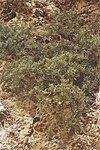User:Fritzmann2002/sandbox
| This is a Wikipedia user page. This is not an encyclopedia article or the talk page for an encyclopedia article. If you find this page on any site other than Wikipedia, you are viewing a mirror site. Be aware that the page may be outdated and that the user in whose space this page is located may have no personal affiliation with any site other than Wikipedia. The original page is located at https://en.wikipedia.org/wiki/User:Fritzmann2002/sandbox. |
A plant micro-reserve (abbr. PMR) is a is a type of small nature preserve that targets rare or threatened plant species, protecting the species' main populations from further decline. They also serve as hotspots for biodiversity monitoring, seed collection, and plant management.
Characteristics
Definition
There is no exact definition of what constitutes a plant micro-reserve. In Crete and Spain, they are considered to be reserves with an area of less than 20 hectares,[1][2] while elsewhere in the Mediterranean the upper limit is 100 hectares. However, they have the shared characteristic of intensively protecting one or several highly threatened plant species, usually endemics.[3] PMRs are organized based on the "singularity", or the individual site, and the "complementarity", or their ability to contribute to a larger patchwork of conservational areas.[4]
While governments may have the authority to seize and conserve land, the area of a plant micro-reserve must be obtained voluntarily. Private or public entities can turn over land to be managed as a PMR, but this agreement is permanent and not revokable. Boundaries are not necessarily defined geographically, but by the plant population of the PMR. As such, the area of some PMRs could shift based on the protected population.[5]
Inside a micro-reserve, certain actions that would damage the protected plants are forbidden. In all PMRs, no human action can be taken that would impact the plants themselves or the soil substrate they live on. The exception to this rule is that livestock ranching may be allowed for plants that rely on grazing to reproduce. Each micro-reserve may also have additional prohibitions on a case-to-case basis, such as restrictions on hiking or climbing. Certain activity is allowed in PMRs that might be forbidden in other types of nature preserves, such as hunting animals and gathering invertebrates.[6]
Purpose
"In situ conservation of rare plants with narrow ecological niche" , protect against uncontrolled urban sprawl by restricting changes to land use.[7]
In nature reserves, focus is usually on animal species; PMRs make up for that by focusing on plant species.[8] Preserve type localities of plant species, maintain wild populations of useful cultivated plants for ethnobotanical study, allow small NGOs and towns to participate in small-scale conservation, allow for education opportunities.[4]
Shortcomings
Poor definition, lack of consideration for evolutionary history, lack of consideration of possible future adaptations, fragmented nature.[3]
Variety of different types of conservation efforts in Europe, from Nature Monuments of just a few square meters to National Parks of massive size.[8]
History
The first plant micro-reserve was established in 1990 in Valencia, Spain. The concept was officially recognized by the European Union in 1994, and started to be funded by its LIFE programme.[1]
By 2001, more than 150 locations had been identified and began the process of recognition,[9] of which 14 were already officially declared plant micro-reserves.[10]
List of reserves
| PMR Name | Target species | Size | Location | Image |
|---|---|---|---|---|
| Fournoti beach, | Hypericum aciferum | 6.5 hectares[11] | 
| |
Proposals and future development
2021, to protect Acis nicaeensis in Monaco in Nice, from urban sprawl, suitable because of disjointed populations.[12]
References
- ^ a b Thanos, Costas (2007). "About Plant Micro-Reserves". Creta Plant. Retrieved 26 April 2024.
- ^ Lumbreras 2001, p. 11.
- ^ a b Médail et al. 2021, p. 2.
- ^ a b Lumbreras 2001, p. 18.
- ^ Lumbreras 2001, p. 19-20.
- ^ Lumbreras 2001, p. 20.
- ^ Médail et al. 2021, p. 1.
- ^ a b Lumbreras 2001, p. 13.
- ^ Lumbreras 2001, p. 14.
- ^ Lumbreras 2001, p. 24.
- ^ Thanos et al. 2013, p. 28.
- ^ Médail et al. 2021, p. 7.
Bibliography
- Médail, Frédéric; Diadema, Katia; Pouget, Marine; et al. (2021). "Identification of plant micro-reserves using conservation units and population vulnerability: the case of an endangered endemic Snowflake (Acis nicaeensis) in the Mediterranean Basin hotspot". Journal for Nature Conservation. 61 – via ScienceDirect.
- Lumbreras, Emilio (2001). The micro-reserves as a tool for conservation of threatened plants in Europe. Nature and Environment. Vol. 121. Council of Europe. ISBN 92-871-4664-0.
- Thanos, Costas; Fournaraki, Christini; Georghiou, Kyriacos; et al. (2013). "PMRs in western Crete" (PDF). Plant Micro-Reserves: From Theory to Practice. Utopia Publishing. ISBN 978-618-80647-2-0.

